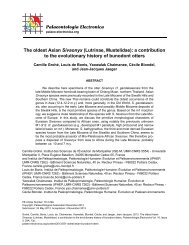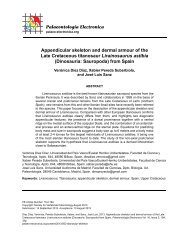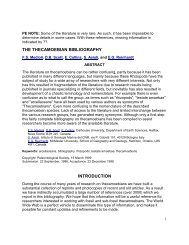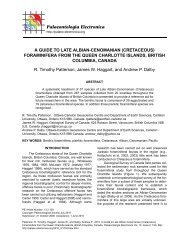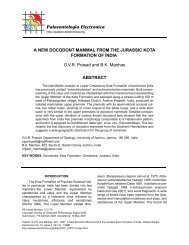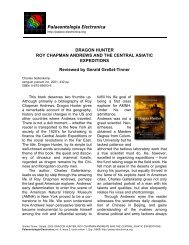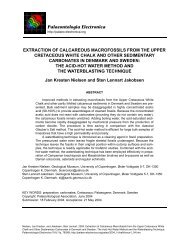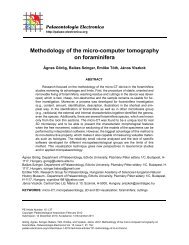Illustration of Modern Benthic Foraminifera from Bermuda and ...
Illustration of Modern Benthic Foraminifera from Bermuda and ...
Illustration of Modern Benthic Foraminifera from Bermuda and ...
Create successful ePaper yourself
Turn your PDF publications into a flip-book with our unique Google optimized e-Paper software.
JAVAUX AND SCOTT: BENTHIC FORAMINIFERA FROM BERMUDA<br />
waters, far <strong>from</strong> the continent (1,000 km east <strong>of</strong><br />
Cape Hatteras). A comparison with previous studies<br />
<strong>of</strong> foraminiferal distributions in subtropical/tropical,<br />
continental-margin or insular environments<br />
such as the Gulf <strong>of</strong> Mexico, the Caribbean Sea,<br />
<strong>and</strong> the Florida-Bahamas platform shows general<br />
similarities with <strong>Bermuda</strong> despite some differences<br />
(Javaux 1999).<br />
Study area<br />
<strong>Bermuda</strong> is a chain <strong>of</strong> approximately 150 oceanic<br />
isl<strong>and</strong>s located at latitude 32°N <strong>and</strong> longitude<br />
65°W in the northwest Atlantic Ocean. The isl<strong>and</strong>s<br />
lie on the <strong>Bermuda</strong> Seamount, a volcanic peak<br />
capped by Quaternary limestone. The isl<strong>and</strong>s are<br />
fossil aeolianite dunes, perched on the southeast<br />
margin <strong>of</strong> an elliptical submarine platform (shallower<br />
than 18 m) surrounded by reefs <strong>and</strong> enclosing<br />
a reef-filled lagoon. The seaward margin <strong>of</strong> the<br />
platform extends <strong>from</strong> the platform to the ocean: a<br />
rim <strong>of</strong> coral reefs <strong>and</strong> occasional algal-vermetid<br />
cup reefs (especially on the south side) enclosing<br />
the lagoon, a wide upper terrace at 18 m depth<br />
(relict aeolianite dunes), a ridge (fossil reef) at 14.4<br />
m depth on the outer edge <strong>of</strong> the upper terrace,<br />
<strong>and</strong> a sediment-covered terrace at 73 m depth<br />
(relict aeolianite dunes). These features were<br />
strongly influenced by Quaternary glacio-eustatic<br />
<strong>and</strong> climatic oscillations (Stanley <strong>and</strong> Swift 1968).<br />
The warm waters <strong>of</strong> the Gulf Stream contribute<br />
to the subtropical climate <strong>of</strong> the <strong>Bermuda</strong><br />
isl<strong>and</strong>s. A northern equatorial current joins the Gulf<br />
Stream after passing on the east side <strong>of</strong> the Bahamas.<br />
The <strong>Bermuda</strong> carbonate platform includes a<br />
wide range <strong>of</strong> environments such as mangrove<br />
swamps, lagoons, l<strong>and</strong>locked marine ponds,<br />
marine caves, <strong>and</strong> reefs. The isl<strong>and</strong>s have no rivers.<br />
Reefs are built by corals <strong>and</strong> algae, <strong>and</strong> are<br />
encrusted by numerous organisms including the<br />
foraminifera Homotrema rubrum (Lamarck). The<br />
<strong>Bermuda</strong> platform includes numerous types <strong>of</strong><br />
reefs differing by their size, shape, <strong>and</strong> main<br />
framework-building organisms (corals or algae)<br />
(Logan 1988). The reef organisms are less diverse<br />
than their Florida <strong>and</strong> Caribbean counterparts.<br />
Fringing mangrove swamps are almost exclusively<br />
concentrated along the north shore <strong>of</strong> the isl<strong>and</strong>s,<br />
as well as in protected bays <strong>and</strong> around l<strong>and</strong>locked<br />
marine ponds. Mangrove swamps develop in very<br />
sheltered areas in bays, sounds, narrows <strong>and</strong><br />
channels. Swamp floras are similar to those in the<br />
Gulf <strong>of</strong> Mexico at 23°N, <strong>and</strong> are composed <strong>of</strong> the<br />
black mangrove (Avicennia germinans), the red<br />
mangrove (Rhizopora mangle), <strong>and</strong> the buttonwood<br />
(Canocarpus erectus), with the Brazil pepper<br />
tree (Schinus portulacastrum) invading the<br />
swamps.<br />
The recent sediments are nearly 100% calcium<br />
carbonate, <strong>and</strong> are derived almost entirely<br />
<strong>from</strong> skeletal material <strong>of</strong> benthic invertebrates<br />
(zooantharian? corals, gorgonians, sponges,<br />
bivalves, gastropods, foraminifera) <strong>and</strong> calcareous<br />
algae, or <strong>from</strong> surrounding limestones (Upchurch<br />
1970; James <strong>and</strong> Schenk 1983). Borers (bivalves,<br />
sponges such as Cliona, polychaete worms, <strong>and</strong><br />
barnacles) produce the major portion <strong>of</strong> reef sediment.<br />
Grazers (parrot fish, sea urchins, <strong>and</strong> chitons),<br />
<strong>and</strong> physical weathering also contribute to<br />
the destruction <strong>of</strong> rock <strong>and</strong> reef. L<strong>and</strong> erosion is<br />
important only in nearshore <strong>and</strong> inshore environment<br />
(Morris et al. 1977).<br />
METHODS<br />
Sampling <strong>and</strong> processing<br />
In May 1993 <strong>and</strong> February 1995, about 200<br />
samples <strong>of</strong> the top 1 cm <strong>of</strong> surface sediment were<br />
collected in environments representing a range <strong>of</strong><br />
physical, chemical, <strong>and</strong> biological conditions (Javaux<br />
1999). Live (Rose Bengal stained) <strong>and</strong> total<br />
assemblages were determined in fractions <strong>of</strong> split<br />
samples including at least 300 specimens. Quantitative<br />
analyses <strong>of</strong> foraminiferal distribution in <strong>Bermuda</strong><br />
can be found in Javaux (1999).<br />
Identifications <strong>of</strong> foraminiferal species were made<br />
using Bermudez <strong>and</strong> Seiglie (1965), Bock (1971),<br />
Brady (1884), Buzas <strong>and</strong> Severin (1982), Cimmermann<br />
<strong>and</strong> Langer (1991), Cushman (1917, 1918-<br />
31), Steinker (1980), Todd <strong>and</strong> Brönnimann (1957),<br />
<strong>and</strong> Wantl<strong>and</strong> (1975). The generic nomenclature<br />
follows Loeblich <strong>and</strong> Tappan (1964, 1988).<br />
The distributions <strong>of</strong> the benthic foraminiferal<br />
species illustrated in this paper are summarized<br />
with each species in the remarks section <strong>of</strong> the<br />
systematics. These remarks include the distribution<br />
both in <strong>Bermuda</strong> <strong>and</strong> in other subtropical/tropical<br />
areas, summarized in Tables 1, 2, <strong>and</strong> 3. The<br />
data for benthic foraminifera distribution <strong>from</strong> <strong>Bermuda</strong><br />
in brackish-water, nearshore <strong>and</strong> lagoons,<br />
backreef-reefs, <strong>and</strong> forereef-inner shelf-outer shelf<br />
(5 to 60 meters depth) is mostly new <strong>and</strong> comes in<br />
a large part <strong>from</strong> Javaux (1999), but also <strong>from</strong><br />
Barnhardt (1963), MacKenzie et al. (1965),<br />
Pestana (1983), Steinker <strong>and</strong> Clem (1984). Data<br />
for Florida-Bahamas is <strong>from</strong> Bock (1971), Todd <strong>and</strong><br />
Low (1971), Rose <strong>and</strong> Lidz (1977), Steinker <strong>and</strong><br />
Steinker (1976), Steinker et al. (1977), Levy,<br />
(1991), <strong>and</strong> Hallock <strong>and</strong> Peebles (1993); data for<br />
Tobago is <strong>from</strong> Radford (1974); data for Jamaica is<br />
<strong>from</strong> Martin <strong>and</strong> Liddell (1988) <strong>and</strong> Buzas et al.<br />
(1977); data for St. Lucia is <strong>from</strong> Sen Gupta <strong>and</strong><br />
2



